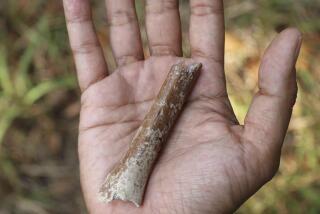Q&A: South African fossils said to reveal new human relative
- Share via
NEW YORK — Researchers said Thursday that they had discovered a previously unknown relative of humans, revealed by bones found deep in a South African cave. Here’s a quick look at the discovery:
WHAT DID THEY FIND?
They recovered some 1,550 fossils, from the skeletons of at least 15 individuals. The cave is about 30 miles northwest of Johannesburg.
HOW OLD ARE THE BONES?
Nobody knows. The researchers said they’ve been unable to get a date, but that they will keep trying.
WHAT IS THIS CREATURE?
Based on details of the bones, the scientists say in the journal eLife that it’s new to science but a member of the evolutionary group called Homo, which includes modern people and our closest extinct relatives. The anatomy combines traits found in other Homo species with more primitive ones. The researchers conclude it’s an early member of Homo, but they don’t claim it’s a direct ancestor of modern people. Experts said they don’t believe it is.
WHAT DO THEY CALL IT?
Homo naledi (nah-LEH-dee). The second name, which means “star” in a local language, was chosen because the bones were found in the Rising Star cave system.
HOW DID THE BONES GET INTO THE CAVE?
That’s a mystery. They were found in a room that can be reached only by following a complicated pathway and squeezing through narrow passages. There’s no sign that naledi lived there. The bones evidently were not dragged in by predators. Maybe the room was used to dispose of bodies, the researchers suggest.
___
Online:
eLife: https://elifesciences.org/
___
Malcolm Ritter can be followed at https://www.twitter.com/malcolmritter
Copyright 2015 The Associated Press. All rights reserved. This material may not be published, broadcast, rewritten or redistributed.
More to Read
Sign up for Essential California
The most important California stories and recommendations in your inbox every morning.
You may occasionally receive promotional content from the Los Angeles Times.










